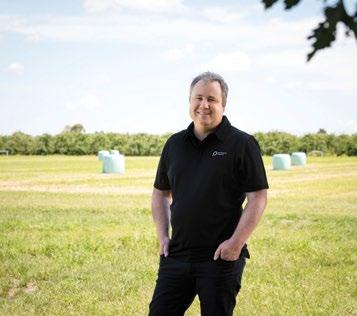
2 minute read
Linking biology and technology for food production
LINKING BIOLOGY
AND TECHNOLOGY FOR FOOD PRODUCTION
Words by Prue Scott
Dr Paul Johnston is science group leader of field crops at Plant & Food Research Ltd
Hydroponics took Dr Paul Johnstone’s fancy at high school. How could plants really grow in water? He went on to study horticulture at Massey University where he gained his PhD and then spent five years in California undertaking research for the vegetable industry.
“My studies gave me a great appreciation of underlying plant physiology and critical scientific processes. But I quickly realised I was drawn to how we could apply knowledge to create value for growers and in doing so promote practices that addressed important environmental challenges,” says Paul, who leads Plant & Food Research’s Cropping Systems & Environment science group.
The group’s expertise covers environmental impacts, land use, climate change, systems modelling and soil and plant science.
“My own background is vegetables, but I’ve worked a lot with arable and forage crops too and looking at a diverse range of science including nutrient and water management, crop physiology, land use and soil health, environmental impacts and climate change. I’m a generalist who becomes quite excited about possibilities for R&D and seeing our science being applied in practice.”
That leads to digital horticulture. “We’re really interested in the role digital technologies can play in transforming food systems. Some of our work is linking plant and soil sensors to grow crops more precisely.This makes sure that plants receive the inputs they need to grow best, and at the same time, reduce unnecessary costs for growers and minimise potential impacts on the environment.
“We’re also starting on a major new initiative to build ‘digital twins’ or virtual models, of our production systems and supply chains so we can consider the impacts of future changes on important productivity, quality and sustainability outcomes. By working virtually first, we can speed up and de-risk our research.This work will provide better insights to help our industries respond to major issues such as climate change, greenhouse gas emissions and freshwater reform,” he says.
Paul works closely with industry. One recent example he cites was working with other researchers and a major vegetable processor as they rapidly scaled up beetroot production in the Hawke’s Bay. “This put real pressure on the company to consistently produce the right amounts of right-sized beetroot at the right time to feed the factory and meet market demand for different product ranges.”
Working in partnership, a new tool was created that helped crop managers and growers understand the impacts of variety and time of planting on beetroot size and factory scheduling, and to assist in the management of nutrients to optimise productivity and quality.










